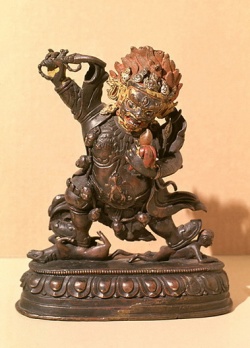Begtse (Cam sring)
By Cathleen Cummings
26 May, 1998
Begtse is worshipped in Tibet as one of the Eight Dharmapala, the Guardians of the Buddhist Dharma; as a god of war; and as a special protector of the Gelugpa sect. The name Begtse means "hidden coat of mail" but in Tibet Begtse is also commonly known as lCam sring, meaning "brother and sister," for he is often shown alongside his sister gDong dmar ma.
Begtse, along with Pehar and several other deities in the Gelugpa pantheon, have their origins as pre-Buddhist [[Wikipedia:Central Asian|Central Asian]] war gods. They still bear the attributes of warriors, such as coats of mail, helmets, weapons, and armies, that allude to the [[Wikipedia:Central Asian|Central Asian]] ideal of the warrior-king possessed of divine powers, from whom these deities originated. Once included in the Buddhist pantheon Begtse and similar figures were given a new mission to fight the enemies of the doctrine, the dharma.
The precise moment ofBegtse's incorporation into the Tibetan pantheon is difficult to gauge. According to one well-known legend, Begtse originated as a Mongolian pre-Buddhist protector deity who was converted when the Third Dalai Lama traveled to Mongolia to convert Altan Khan in 1577. However, it has recently been suggested by Amy Heller that Begtse was actually known in Tibet as early as the fifteenth century, when his teachings were taught by the First Dalai Lama. Subsequently, Begtse was specially favored by the Second Dalai Lama and, along with Palden Lhamo, was made protector of his personal monastery, established in 1509. Later, the Fifth Dalai Lama made Begtse a protector of the Tibetan government and he continues to be considered a personal protector of the Dalai Lamas. Begtse is also the chief protector deity of Mongolia.
Begtse resides in a red, four-cornered copper mountain rising up from the center of a lake formed by the blood of men and horses. Short and thick-limbed, his body is a ruby-red color, and his three eyes stare with hatred at the enemies of Buddhism. He wears a cuirass of copper, a garment of red silk, a goat-skin cloak, and high Mongolian boots, with a garland of fifty freshly-severed heads around his neck.
Begtse stands in the archer pose, and is usually depicted trampling upon the bodies of a horse and a human figure which lie atop the pedestal that is now missing. With his right hand he wields a scorpion-handled sword for cutting those who have broken their vows. His left hand normally holds the heart and kidneys of enemies of the faith, and in the crook of his left arm a banner, bow and arrow; these attributes are also missing. The loss of these elements can be explained by the fact that such figures are often cast in pieces: the pedestal and attributes, and in some cases even the crown, garland, earrings, scarves, and fish pendant, were made separately and later assembled.
References:
Patricia Berger and Therese Tse Bartholomew, eds. Mongolia: The Legacy of Chinggis Khan. 1995: Asian Art Museum of San Francisco.
Amy Heller. "Historic and Iconographic Aspects of the Protective Deities Srung-ma dmar-nag." In Tibetan Studies, Vol. I. Ihara and Yamaguchi, eds. Narita: Naritasan Shinshoji, 1989.
Nebesky-Wojkowitz, René de. Oracles and Demons of Tibet: The Cult and Iconography of the Tibetan Protective Deities. Mouton: 's-Gravenhage, 1956.
Terese Tse Bartholomew, Mongolia: The Legend of Chinggis Khan, Patricia Berger and Therese Tse Bartholomew, eds., 1995: Asian Art Museum of San Francisco, pg. 244.
Heller, "Historic and Iconographic Aspects of the Protective Deities Srung-ma dmar-nag," In Tibetan Studies, Vol. I, edited by Ihara and Yamaguchi. Narita: Naritasan Shinshoji, 1989. p. 429.
